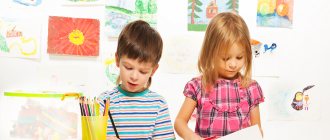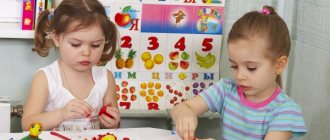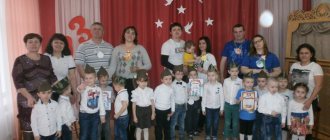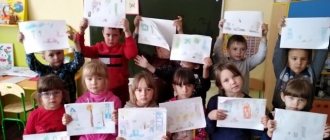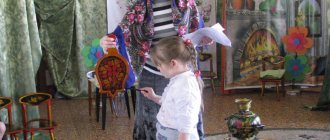Fine art lesson in kindergarten on the topic: “Spoon painting (Khokhloma)”
Summary of a lesson on art activities in the senior group
Topic: “ Spoon painting (Khokhloma)”
Program content:
-Continue to introduce children to Khokhloma products. Introduce a new element - curl. Strengthen the ability to draw berries (with a stamp), leaves, grass. Teach children to make a pattern in a circle. Convey the color of the painting, the combination of color, background and elements of the plant pattern. -Develop aesthetic perception, sense of color, composition. -Cultivate love and respect for working people.
Demonstration material:
exhibition of Khokhloma paintings, images of Khokhloma products.
Handout materials:
wooden spoons, gouache, brushes, cotton swabs, napkins, stands for brushes, cups for water.
Audio material:
song “Our Khokhloma” by Yu. Chichkov, song “Russian Spoons”
Progress of the lesson:
Russian folk music sounds. Khokhloma products
are placed on the tables in front of the children Educator: Who needs dishes for porridge-okroshka, a miracle dish and cups, spoons?
Come, honest people, to our exhibition. Don't pass by, be our dear guests at our wonderful exhibition. Admire the products of great masters. Look at these products guys. How can they be called in one word? - Dishes. — Are the dishes here the same? - No. - Here are the cups, here are the spoons, the samovar and the ladle. - What is this dish similar to? Pick up one product at a time and look at it carefully. How is this dish similar? — It is made of wood, identical elements of the pattern (curls, grass, leaves, a twig with berries), the pattern is made on a black or yellow background. - What is the name of this dish? Who has already guessed? -Khokhloma dishes Yes, Golden Khokhloma itself has come to you! A golden grass grew on a spoon, a flower blossomed on a bowl, a cranberry ripened on a ladle. There is no shame in putting such dishes on the royal table. How did this wondrous wonder appear - “golden Khokhloma”? An old legend tells: once upon a time there lived a man in the Nizhny Novgorod forests, on the banks of a quiet river. We don’t know who he is or where he came from. That man carved wooden bowls and spoons and painted them so that
they seemed to be made of pure gold.
The king found out about this and became angry: “Why don’t I have such a master in my palace?! Give it to me! Immediately!" He tapped his staff, stamped his foot, and sent soldiers to take the craftsman to the palace. The soldiers set off to carry out the royal order, but no matter how much they searched, they could not find the miracle master. He went to God knows where, but first he taught local peasants how to make “golden” dishes. In each hut cups and spoons sparkled with gold. A lot of “golden” dishes were sold at a fair in the village of Khokhloma. This is how the name “golden Khokhloma” was born. Let's remember once again what plant elements the Khokhloma pattern consists of - Berries, leaves, curls, bushes. (I demonstrate in the pictures) - Look, there are scarlet bunches of rowan, and a ripe strawberry, and curls of herbs and leaves. And most importantly - a shimmering golden background, which makes the product more elegant and festive - Guys, I noticed the basket that stands in the corner. Maybe someone forgot her. Let's look into it (take out spoons). - Someone left us these spoons. Maybe the craftsmen who brought us their products? Look, the spoons are not simple, but wooden. But they just don’t have a pattern, and they don’t look exactly festive. Guys, do you want to become real master artists of Khokhloma and paint these spoons. And now, everyone sat down at the tables together, everyone looked at me. (put on aprons) - What colors will we need to make the pattern? (black, red, green) (showing samples of painted spoons)
- Guys, look at the samples of spoons and tell me what elements make up the pattern on these spoons? - The pattern consists of a branch with berries, leaves, curls and grass. - What is the main rule when making a pattern?
(the elements of the pattern should be located rhythmically, at the same distance, repeating the elements evenly)
.
— First you need to draw a curved branch with the end of the brush. Then berries and leaves are depicted on the branch (leaves can be drawn with the end of a brush, by dipping, and berries can also be drawn with the end of a brush or by poking)
.
Then, near the berries and leaves, you can draw blades of grass - with (arched)
. But you can also draw berries with a stamp (cotton swab). Watch how I paint the spoon. In the center of the spoon we draw a curl, one after another. From the curl, I draw blades of grass with the tip of the brush. But let’s draw the berries with a stamp. - Now you will become masters - artists of Khokhloma and decorate wooden spoons with patterns. Now let's get to work. Children’s independent work is accompanied by music (the song “Our Khokhloma” by Yu. Chichkov is played.) When the children draw berries and leaves, advise them to add small details to the berries at their ends (dots or “antennae”, and veins (black) on the leaves). Analysis of children's works. - Now look and find the spoons that are most similar to Khokhloma ones, select and show the most beautiful spoon. Tell us about it: what color it is, what colors it is painted with, what berries are on the pattern, why this spoon is better than others. - Guys , you tried very hard, now our fair will be replenished with Khokhloma spoons. - The Khokhloma painting, like a witch’s, asks for a fairy-tale song And nowhere in the world are there such inflorescences Of all the wonders more wonderful than our Khokhloma And now I’ll ask the perky musicians to come out here. - Well, take the spoons apart, Start dancing with us. Song “Russian Spoons”.
Continue to introduce children to different types of folk arts and crafts. Learn to notice artistic elements that determine the specifics of “golden Khokhloma”: the purpose of objects, material, manufacturing technology (in the most general terms, accessible to children), color, pattern. Learn to draw patterns on paper from plant elements (grass, Kudrina, berries, flowers) based on Khokhloma painting, use decorative elements when designing homemade books. Develop technical skills - skillfully use a brush (paint with the tip of the brush, with the whole brush, move freely in different directions). To cultivate an aesthetic attitude towards everyday culture and objects of art.
Preliminary work.
Acquaintance with folk arts and crafts, conversation about traditional crafts. Excursion to a folk art museum or a local history museum (with a teacher, art historian or with parents on weekends.) Organization in kindergarten of a mini-museum or “museum in a suitcase” (“in a chest”), the exhibits of which can be antiques and folk decorative items -applied art brought by parents for temporary exhibition.
Preparation of “books” for illustration by children in three subsequent drawing classes. The teacher carries out this work himself or together with the children in independent artistic activities. The book is made as follows: two sheets of white paper are folded in half, one is inserted into the other and fastened with a stapler or sewn with a needle and thread.
Materials, tools, equipment.
Album for children's creativity "Golden Khokhloma", a guide to familiarize yourself with the characteristic elements and color combinations of different types of folk arts and crafts.
Contents of the lesson.
Before class, the teacher displays objects with Khokhloma painting on the table or on a large stand and invites the children to admire them.
An approximate story from a teacher “Golden Khokhloma”.
— The village of Khokhloma, Nizhny Novgorod region, where fairs selling wooden utensils and painted spoons have been held since ancient times, gave its name to a whole craft that is now widely known in our country and abroad. The village is called Khokhloma, and the dishes that are made here are also called “Khokhloma”. For many, many years, craftsmen here have been making wooden ladles, supplies (suppliers), bratins, spoons... Nowadays, craftsmen have learned to make modern sets of dishes - for juices, ice cream, jam, salads, etc., as well as decorative dishes, candlesticks, children's furniture.
All items made by folk craftsmen are very bright, elegant, festive, and colorful. For this, masters have to work hard. First, the dishes are cut out of wood or turned on a machine. Then they are covered with a layer of liquid clay, dried, soaked in linseed oil and slightly dried. After this, they are coated with a special metal powder and painted with beautiful patterns. Finally, they are coated with special oil (linseed oil) and dried in ovens. Metal powder and oil, after heating in an oven, give the products a unique golden shine, which is why the craft itself and all products are called “golden Khokhloma”. Gold - because all objects shine like gold.
Craftsmen choose paint colors for patterns that go well with the golden background. Which ones do you think? Yes! Red, black, green, brown and yellow. This is the peculiarity of this genre; it has its own strict rules.
Look at this dishes and tell me, what patterns do the craftsmen decorate their products with? Yes, the favorite patterns of the masters of Khokhloma painting are twigs, bushes, berries, and flowers. The twigs and bushes in these patterns are special. Masters love to paint them and affectionately call them “grass.” Sometimes artists paint grass as if all the leaves and blades of grass have turned into curls. Such branches and bushes are called “Kudrina” (from the words - curls, curly).
Consider these patterns (the teacher shows the children tables with options for elements and patterns). Now I will show you how to draw “grass” and “curls”. The teacher introduces the children to the options for floral patterns (see picture) and invites them to try to draw first the grass, and then berries and flowers. The teacher shows the children the basis of future baby books and explains that they themselves will draw pictures in these books to give them to the kids.
- Today we will draw a fabulous - golden - forest. Listen: golden forest - golden Khokhloma... Let's draw the forest like the Khokhloma masters. In this forest there will be bushes, twigs, trees with leaves - grass and Kudrina, with berries and flowers. Children draw a “golden forest” based on Khokhloma painting on the first spread of the book and at the end of the lesson they look at who got which forest and whether it looks like golden Khokhloma.
After class. Decorative drawing and appliqué based on Khokhloma painting - on a strip, circle, in the corners of the page of a future book (in the shape of a square or rectangle).
